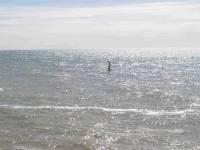Ghosts and negative ion detectors

Causes of ion concentrations
Any surface charged with static electricity (including people!) will attractions, so producing a local concentration. So you need to be careful handling negative ion detectors. Certain materials, like plastics, can hold higher charges than others and so cause bigger ion concentrations. Even breathing on ion detectors can change the reading! Detectors should be earthed to try to minimise these effects.
Ion concentrations are blown around by winds and draughts. So, a breeze or draught across your detector could cause a varying reading that has nothing to do with ghosts..
The presence of electrical equipment can affection concentrations, too. A cathode ray type TV screen, for instance, will have a strongly positively-charged surface. Obviously, the presence of air ionisers is also going to have an effect.
It is even possible that mains powered equipment may cause ion distribution changes with its electric field. Although the ions will move backwards and forwards as the field varies rapidly (at 50 or 60Hz) there will be some clumping because of the different sizes of negative and positive ions.
Negative Ion Detectors
Negative ion detectors (NIDs) are popular with paranormal researchers. Intriguingly, it is not easy to see why. There is a widely accepted idea that ghosts are in some way associated with an excess of negative ions though opinions vary as to why. If there is any evidence that ghosts are associated with negative ions (such as ion concentration being shown to vary on a meter when a ghost is seen), it seems to be impossible to find on the web (if anyone has seen any such evidence, please get in touch)! So how this supposed association originally arose is a mystery (like the idea of EMF meters acting as ghost detectors).
There are problems with negative ion detectors. They tend to be very inaccurate compared to the other equipment typically used in paranormal research. Even quite expensive meters are only accurate to plus or minus 25%! Cheaper models sometimes don't even have a scale. They 'go off' (a light shines or a buzzer sounds) to indicate that a certain threshold has been passed (but you don't know by how much). It is easy to 'set off' such meters with a little static electricity, such as combing your hair nearby.
NIDs measure the concentration of negative ions in the air. Negative ions are almost always, however, associated with similar numbers of positive ions. So, where there is a high negative ion concentration there will always be a high positive ion concentration too. So, are ghost researchers really looking for high numbers of negative AND positive ions combined? Unfortunately, a negative ion detector will only tell you the concentration of negative ions. It won't even tell you if there are more positive or negative ions about. For that, you need a general purpose ion detector which some researchers use instead.
Interestingly, if there are large concentrations of both negative and positive ions about, they may well be close together. This means you may find that negative ion detectors show big deflections. This would be caused by the clouds of ions moving around in the air. Ions don't just sit around, they are highly mobile being pulled around by electric fields (particularly from charged surfaces) and each other.
As with other instruments used in paranormal research, 'air ions' is a complex subject. Unless you understand it reasonably well, you won't be able to judge your results.
Air ions
As well as negative ions, there are positive ions floating round in the atmosphere too (known collectively as air ions). Air ions occur when an electron is knocked off an air molecule (a positive ion) and attaches itself to another one (forming a negative ion). Ions are thus always formed in pairs of negative and positive ions.
Most ions are created by radioactivity and cosmic rays. They usually only last for a matter of minutes before a negative ion meets a positive ion leaving two neutral molecules again. Ions can also attach themselves to solid surfaces causing them to become charged.
In general, there is usually a higher concentration of positive ions (by about 25%) in the air. This is because the positive ions are bigger and so move more slowly, hence diffusing (eg. into charged surfaces) more slowly than negative ions.
Concentrations are high in mountains (2000 negative ions per cubic centimetre compared to 2500 positive ions). At sea level, the figures are nearer to 1500 and 1800 respectively. After a storm, the balance may reverse sharply for a while. Concentrations inside buildings are much lower (typically 150 neg; 200 pos).
Evaporating water can cause an excess of negative ions over positive ones. This is why waterfalls and the seaside have higher negative ion concentrations.
Ion concentrations can vary over short distances, particularly indoors. You may find that one end of a room has an excess of positive ions and the other end, negative. Outside, variations tend to occur over longer distances.
It is not easy measuring air concentrations and accuracy is generally low.